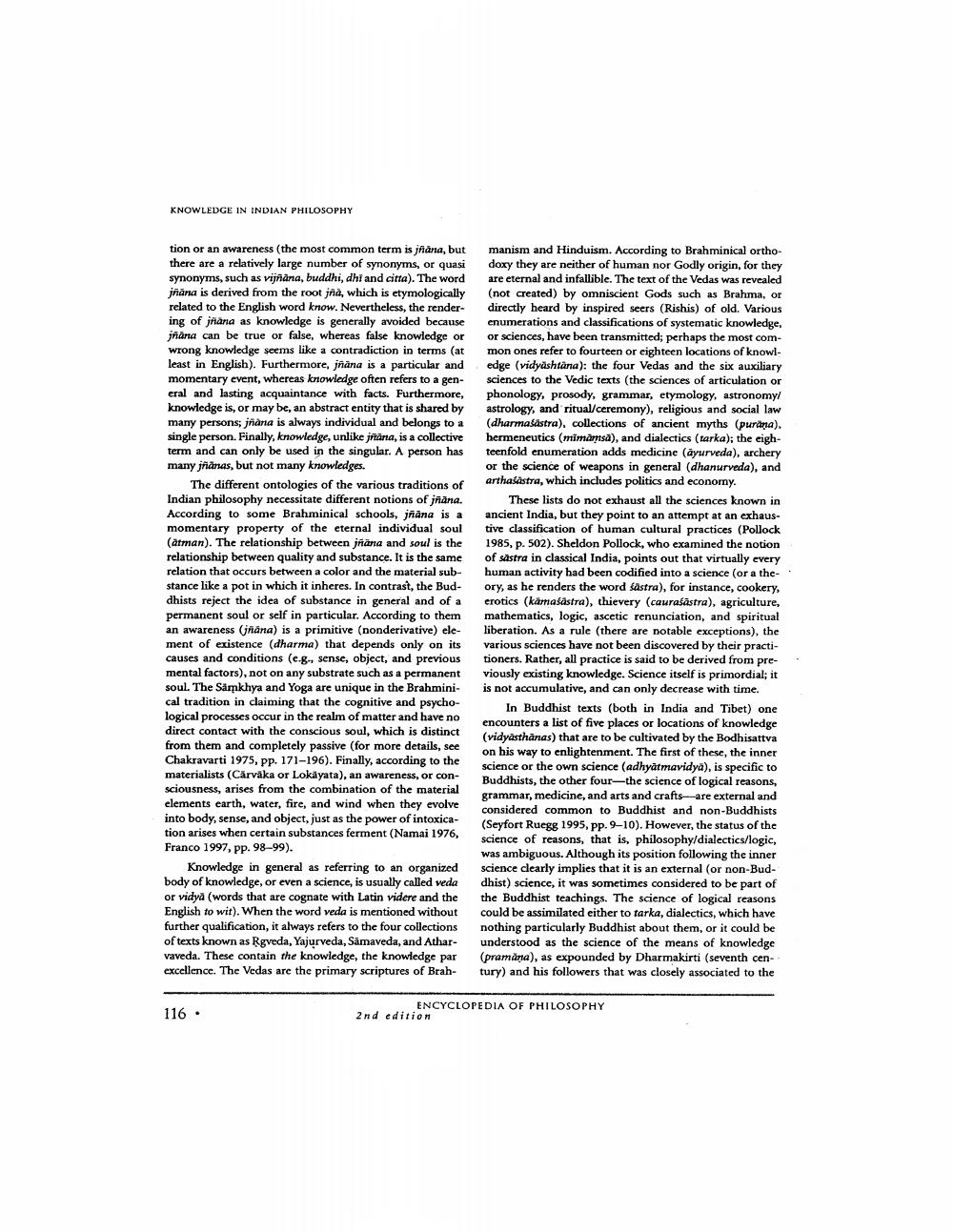Book Title: Knowledge In Indian Philosophy Author(s): Publisher: View full book textPage 2
________________ KNOWLEDGE IN INDIAN PHILOSOPHY tion or an awareness (the most common term is jnana, but there are a relatively large number of synonyms, or quasi synonyms, such as vijnana, buddhi, dhi and citta). The word jnana is derived from the root jna, which is etymologically related to the English word know. Nevertheless, the rendering of jnana as knowledge is generally avoided because jnana can be true or false, whereas false knowledge or wrong knowledge seems like a contradiction in terms (at least in English). Furthermore, jnana is a particular and momentary event, whereas knowledge often refers to a gen- eral and lasting acquaintance with facts. Furthermore, knowledge is, or may be, an abstract entity that is shared by many persons; jnana is always individual and belongs to a single person. Finally, knowledge, unlike jnana, is a collective term and can only be used in the singular. A person has many jnanas, but not many knowledges. The different ontologies of the various traditions of Indian philosophy necessitate different notions of jnana. According to some Brahminical schools, jnana is a momentary property of the eternal individual soul (atman). The relationship between jnana and soul is the relationship between quality and substance. It is the same relation that occurs between a color and the material substance like a pot in which it inheres. In contrast, the Bud- dhists reject the idea of substance in general and of a permanent soul or self in particular. According to them an awareness (jnana) is a primitive (nonderivative) ele- ment of existence (dharma) that depends only on its causes and conditions (e.g., sense, object, and previous mental factors), not on any substrate such as a permanent soul. The Samkhya and Yoga are unique in the Brahminical tradition in claiming that the cognitive and psychological processes occur in the realm of matter and have no direct contact with the conscious soul, which is distinct from them and completely passive (for more details, see Chakravarti 1975, pp. 171-196). Finally, according to the materialists (Carvaka or Lokayata), an awareness, or consciousness, arises from the combination of the material elements earth, water, fire, and wind when they evolve into body, sense, and object, just as the power of intoxication arises when certain substances ferment (Namai 1976, Franco 1997, pp. 98-99). Knowledge in general as referring to an organized body of knowledge, or even a science, is usually called veda or vidya (words that are cognate with Latin videre and the English to wit). When the word veda is mentioned without further qualification, it always refers to the four collections of texts known as Rgveda, Yajurveda, Samaveda, and Atharvaveda. These contain the knowledge, the knowledge par excellence. The Vedas are the primary scriptures of Brah- manism and Hinduism. According to Brahminical orthodoxy they are neither of human nor Godly origin, for they are eternal and infallible. The text of the Vedas was revealed (not created) by omniscient Gods such as Brahma, or directly heard by inspired seers (Rishis) of old. Various enumerations and classifications of systematic knowledge, or sciences, have been transmitted; perhaps the most common ones refer to fourteen or eighteen locations of knowl. edge (vidyashtana): the four Vedas and the six auxiliary sciences to the Vedic texts (the sciences of articulation or phonology, prosody, grammar, etymology, astronomy/ astrology, and ritual/ceremony), religious and social law (dharmasastra), collections of ancient myths (purana), hermeneutics (mimamsa), and dialectics (tarka); the eighteenfold enumeration adds medicine (ayurveda), archery or the science of weapons in general (dhanurveda), and arthasastra, which includes politics and economy. These lists do not exhaust all the sciences known in ancient India, but they point to an attempt at an exhaustive classification of human cultural practices (Pollock 1985, p. 502). Sheldon Pollock, who examined the notion of sastra in classical India, points out that virtually every human activity had been codified into a science (or a theory, as he renders the word sastra), for instance, cookery, erotics (kamasastra), thievery (caurasastra), agriculture, mathematics, logic, ascetic renunciation, and spiritual liberation. As a rule (there are notable exceptions), the various sciences have not been discovered by their practitioners. Rather, all practice is said to be derived from previously existing knowledge. Science itself is primordial; it is not accumulative, and can only decrease with time. In Buddhist texts (both in India and Tibet) one encounters a list of five places or locations of knowledge (vidyasthanas) that are to be cultivated by the Bodhisattva on his way to enlightenment. The first of these, the inner science or the own science (adhyatmavidya), is specific to Buddhists, the other four--the science of logical reasons, grammar, medicine, and arts and crafts are external and considered common to Buddhist and non-Buddhists (Seyfort Ruegg 1995, pp. 9-10). However, the status of the science of reasons, that is, philosophy/dialectics/logic, was ambiguous. Although its position following the inner science clearly implies that it is an external (or non-Buddhist) science, it was sometimes considered to be part of the Buddhist teachings. The science of logical reasons could be assimilated either to tarka, dialectics, which have nothing particularly Buddhist about them, or it could be understood as the science of the means of knowledge (pramana), as expounded by Dharmakirti (seventh century) and his followers that was closely associated to the 116 . ENCYCLOPEDIA OF PHILOSOPHY 2nd editionPage Navigation
1 2 3 4 5 6 7 8 9
